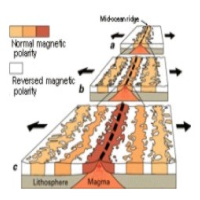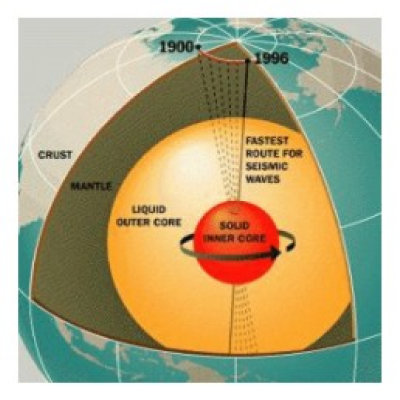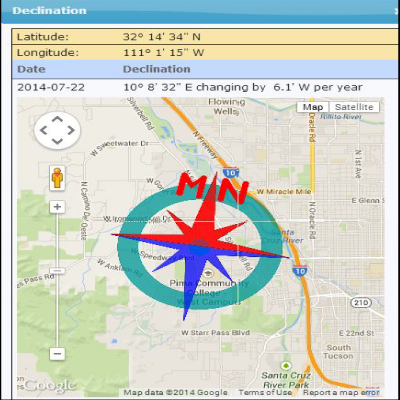With decline in interest about global warming within the general population, the alarmist press (e.g. Daily Mail) and some formerly reputable science magazines ( Discover, Smithsonian, Scientific American) have been promoting another scary scenario: a reversal of the Earth’s magnetic field alleging some possibly dire consequences should it occur. Such speculation was especially plentiful in 2012 during the Mayan doomsday calendar frenzy and it continues today. The links above are all from this year. But doomsday speculations are unfounded. The magnetic poles have switched many times, apparently at random intervals with no evidence that it has a profound effect on life.
The last time Earth’s magnetic field reversed was 780,000 years ago. To see the history of such reversals, see the Geological Society of America’s Geologic Time Scale: http://www.geosociety.org/science/timescale/timescl.pdf The black and white striped column near the left side shows the timing and duration of each reversal.
We know when these reversals occurred because magnetic polarity is recorded in the rocks.
 At mid-oceanic ridges, fresh magma reaches the surface and spreads out. Magnetic minerals align with the magnetic polarity existing at the time and are locked in as the magma solidifies. (Diagram from NASA).
At mid-oceanic ridges, fresh magma reaches the surface and spreads out. Magnetic minerals align with the magnetic polarity existing at the time and are locked in as the magma solidifies. (Diagram from NASA).
The Earth’s magnetic field is produced by the interaction of the Earth’s solid iron core with the liquid outer core. The inner core spins slightly faster than the earth rotates on its axis. The spin sets up convection and eddies in the liquid core just like the spin of the Earth produces currents in the oceans and atmosphere. However, the exact mechanism is still subject to controversy, but most hypotheses are variations of the dynamo effect.
The Earth’s magnetic field varies in intensity because of these eddies and because the axis of rotation of the core is not the same as the axis of rotation of the Earth. That means the north magnetic pole is not in the same location as the geographic north pole. In fact, the magnetic poles wander and even vary in location on a daily basis by as much as 50 miles according to the Geological Survey of Canada, the folks who keep track of where the pole is.
The magnetic poles also have a longer-term positional change. Currently the average position of the north magnetic pole is heading out of Canada toward Siberia at the rate of 25 miles per year. See this page for both north and south pole locations.
Some of the concern about an imminent magnetic reversal derives from the fact that the strength of the magnetic field has been decreasing for the last 100 years. But fluctuations in intensity are common. The current strength of the magnetic field is nearly twice as high as the average for the past 2 million years, see graph below (source). The jump shown on the graph was at the last reversal.
But what could happen during a reversal? First, reversals take several thousand years. The magnetic field does not become zero, but even if it did, the sun’s magnetic field and earth’s atmosphere would protect us. (By the way, the sun switches magnetic polarity every 9- to 12 years.)
According to University of California professor Gary Glatzmaier, during a magnetic reversal, the magnetic force field becomes complicated, but does not go away. Glatzmaier used a super computer to model what might happen, see graphic below. (On the left is the normal situation; on the right is what might happen during a reversal.)
We note that there have been many magnetic reversals and there is no evidence that it had a profound affect on life. Humans and humanoids have been through several reversals. Because the reversal process occurs over thousands of years, animals, such as birds, and whales, that may rely on magnetic navigation would have time to adapt.
Some of our own navigation and surveying systems depend on keeping track of where magnetic north (or south) is. Fortunately there is an app for that. This NOAA calculator allows you to get the constantly changing magnetic declination from true north at any location.
As of July 22, 2014, a magnetic compass in Tucson points 10 degrees, 8 minutes, 32 seconds east of true north. But that declination is decreasing by about one second every day which means that in about 100 years, magnetic compasses in Tucson will point true north.
A magnetic reversal any time soon is unlikely. The process has occurred at random intervals in the past and is still poorly understood. The intensity of magnetic flux changes measured in lava is not enough to disrupt electronic communications and is less than we experience when the Sun’s magnetic poles flip every 9 to 12 years. If the magnetic field becomes complicated such as Glatzmaier postulates, we could see auroras borealis (“northern lights”) worldwide instead of just in the Arctic/Antarctic.
[Note: Besides major reversals of the magnetic field, there may also be short-lived “excursions.” The most studied these is the “Laschamp event” which claims to be a magnetic reversal shown in some French lava beds and some sea-floor sediments that happened about 41,000 years ago. See paper abstracts here and here. There have been reports of similar events in other parts of the world. These events are controversial and may be artifacts of dating problems and of known self-reversal processes rather than represent actual polarity reversals. As seen in the graph above, swings in field strength seem to be the norm, reflecting the rather chaotic convection within the core. Apparent magnetic reversals can occur in certain rocks by thermal metamorphism and as a result of an ionic ordering process during and after cooling under special circumstances (see here for instance).]




